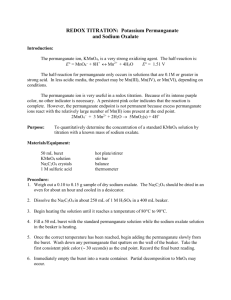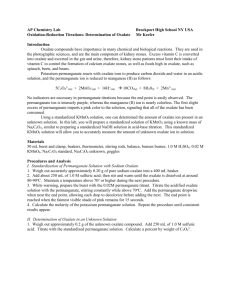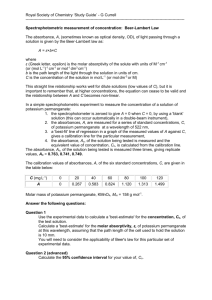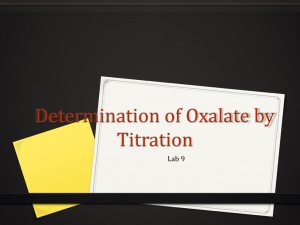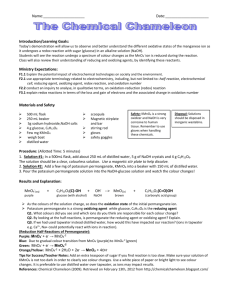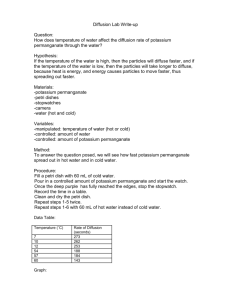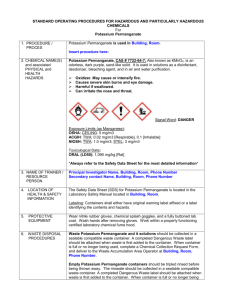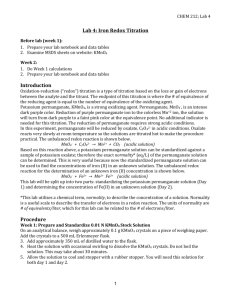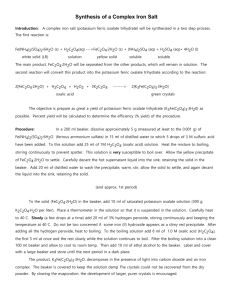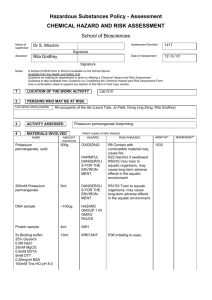Oxidation-Reduction Titrations
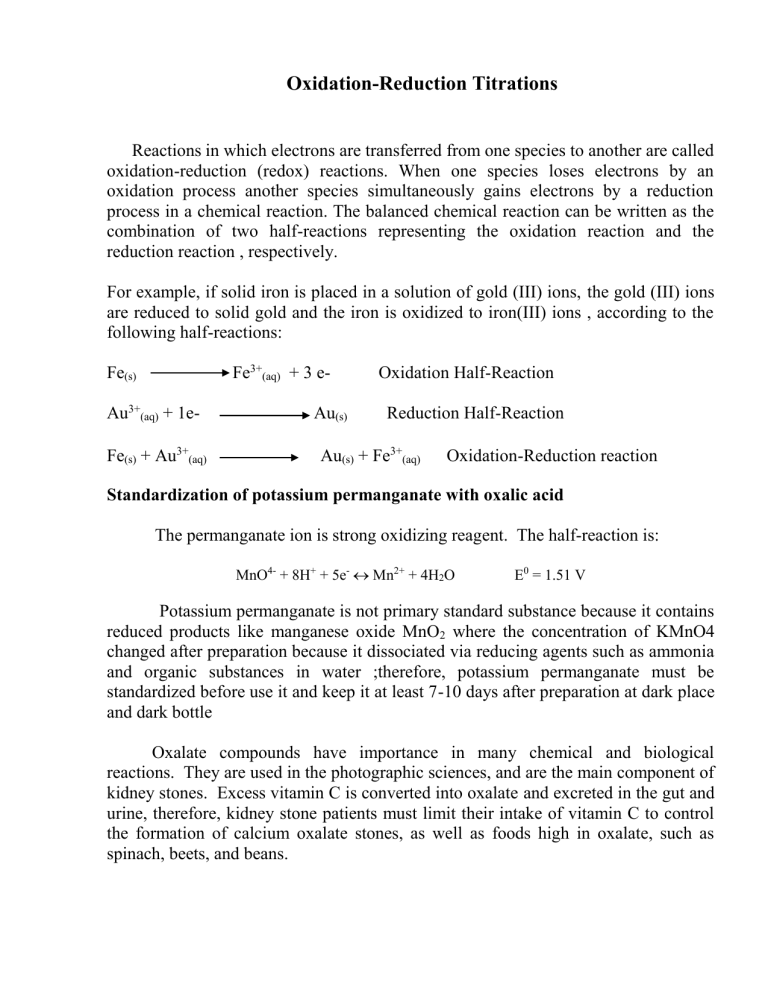
Oxidation-Reduction Titrations
Reactions in which electrons are transferred from one species to another are called oxidation-reduction (redox) reactions. When one species loses electrons by an oxidation process another species simultaneously gains electrons by a reduction process in a chemical reaction. The balanced chemical reaction can be written as the combination of two half-reactions representing the oxidation reaction and the reduction reaction , respectively.
For example, if solid iron is placed in a solution of gold (III) ions, the gold (III) ions are reduced to solid gold and the iron is oxidized to iron(III) ions , according to the following half-reactions:
Fe
(s)
Fe 3+
(aq)
+ 3 e- Oxidation Half-Reaction
Au 3+
(aq)
+ 1e- Au
(s)
Reduction Half-Reaction
Fe
(s)
+ Au 3+
(aq)
Au
(s)
+ Fe 3+
(aq)
Oxidation-Reduction reaction
Standardization of potassium permanganate with oxalic acid
The permanganate ion is strong oxidizing reagent. The half-reaction is:
MnO 4 + 8H + + 5e
Mn 2+ + 4H
2
O E 0 = 1.51 V
Potassium permanganate is not primary standard substance because it contains reduced products like manganese oxide MnO
2
where the concentration of KMnO4 changed after preparation because it dissociated via reducing agents such as ammonia and organic substances in water ;therefore, potassium permanganate must be standardized before use it and keep it at least 7-10 days after preparation at dark place and dark bottle
Oxalate compounds have importance in many chemical and biological reactions. They are used in the photographic sciences, and are the main component of kidney stones. Excess vitamin C is converted into oxalate and excreted in the gut and urine, therefore, kidney stone patients must limit their intake of vitamin C to control the formation of calcium oxalate stones, as well as foods high in oxalate, such as spinach, beets, and beans.
Sodium oxalate is commonly used as a primary standard for determining the concentration of many strong oxidizers used in oxidation/reduction analyses.
Sodium oxalate, Na
2
C
2
O
4
, is a strong electrolyte that dissociates completely in water according to the following equation:
Na
2
C
2
O
4
2 Na
+
(aq) + C
2
O
4
2-
(aq)
Oxidation process of potassium permanganate conducted in acidic, neutral and basic and it’s as follows:
At acidic medium,
MnO
4
-
+ 8H
+ eq.wt,
+ 5e ofKMnO
4
Mn
2+
Mo.wt.
5
At neutral or basic medium like, Sodium or potassium carbonate
MnO
4
+ 8H
2
O + 3 e MnO
2
+ 4OH eq.wt ofKMnO
4
Mo.wt.
3
At strong basic medium,
MnO
4
+ 1e MnO
3 eq.wt ofKMnO
4
Mo.wt.
1
Aqueous solutions of permanganate are not entirely stable because the permanganate ion tend to oxidize water forming manganese dioxide.
4 MnO
4
-
+ 2 H
2
O
4 MnO
2 (s)
+ 3 O
2(g)
+ 4 OH
-
In this experiment, The oxalate ion, C
2
O
4
2, will react quantitatively with permanganate ion, MnO
4
, in the presence of strong acid according to the following equation:
2 MnO
4
(aq) + 5 C
2
O
4
2 (aq) + 16 H + (aq)
2Mn 2+ (aq) + 10 CO
2
(g) + 8 H
2
O
The numerical value of K eq
for the equilibrium is very large. When reaction conditions are anywhere near optimum (in terms of pH and temperature) the reaction can be considered to be quantitative.
Oxidation is defined as the loss of electrons (on right of arrow) or increase in oxidation state (each
C changes from +3 to +4) as shown below by the half-reaction involving oxalate ion.
C2O4
2- → 2 CO
2 + 2 e
-
Reduction is shown by the permanganate ion as it gains electrons and Mn decreases in oxidation state from +7 to +2.
8 H+ + MnO4
- + 5 e- → Mn2+ + 4 H
2O
No indicators are necessary in permanganate titrations because the end point is easily observed. The permanganate ion is intensely purple, whereas the manganese
(II) ion is nearly colorless. The first slight excess of permanganate imparts a pink color to the solution, signaling that all of the oxalate has been consumed.
Apparatus
burette
250-mL Erlenmeyer flasks
10-mL pipette
250-mL volumetric flask
Chemicals
Potassium Permanganate
Sodium Oxalate (AR grade) (0.1 N)
Sulfuric acid ( 6 N)
Procedure
1.
Transfer 10.0 mL of sodium oxalate (0.1 N) to 250 mL conical flask.
2.
Add 5.0mL of 6.0 N sulfuric acid.
3.
shake the solution well and warm it ( 75-80 o C)
4.
Titrate the hot solution against potassium Permanganate solution.
5.
Continue with titration drop by drop till the color is changed from colorless to pink ( permanganate dye)
6.
Repeat the titration for three times and record the mean.
Calculations
No. Start point
End point
1
2
3
Volume of
KmnO
4
V
1
V
2
V
3
The average volume
V
1
V
2
V
3
3
From reaction equation:
2 moles of KMnO
4
≡ 5 moles of oxalic acid
1000mL of 2M KMnO
4
≡ 1000mL of 5M Oxalic acid
V mL
of ? M KMnO
4
10mL of 0.1M Oxalic acid
Molarity of KMnO
4
10
0.1
V mL of KMnO
4
Normality of KMnO
4
5
Molarity
Conc(g/L)o f permengana te
N
eq.wt.
